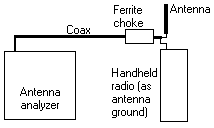 SWR
of vertical HT antennas for VHF and UHF
SWR
of vertical HT antennas for VHF and UHF SWR
of vertical HT antennas for VHF and UHF
SWR
of vertical HT antennas for VHF and UHFDid you ever wonder why the antenna of your handheld transceiver (HT) works so bad in comparison to an antenna on the roof? No, it is not just the position. The antenna which came with your HT is probably just crap - sort of a badly matched dummy load. Instead of providing a proper antenna, the transceiver's output power is increased to several watts, but most of this power is lost and simply empties the battery.
Measurement results
The following table shows the VSWR of several types of antennas as displayed by
an SWR analyzer MFJ-269. To have a realistic counterpoise the antenna can work
against, a handheld transceiver Albrecht RL-402 was used as ground and a
ferrite at the antenna side of the coax to avoid standing waves on the cable
(see diagram). In addition to the SWR on 145 und 435 MHz it was also checked on
which VHF/UHF frequencies an antenna has its minimum SWR. So here we go:
| Type of antenna |
Length incl. plug |
SWR on 145 MHz |
SWR on 435 MHz |
VHF: Min. SWR@MHz |
UHF: Min. SWR@MHz |
| Kenwood TH-F7E | 16 cm | 7 | 2.0 | 1.4 @ 165 | 1.8 @ 461 |
| Baofeng UV-3R | 21 cm | 3.0 | 2.2 | 3.0 @ 145 | 2,0 @ 440 |
| Baofeng UV-5R | 17 cm | 1.1 | 1.3 | 1.1 @ 145 | 1.0 @ 428 |
| Diamond SRH519 | 21 cm | 1.2 | 1.6 | 1.2 @ 145 | 1.6 @ 435 |
| Comet SMA-24 | 44 cm | 1.4 | 2.5 | 1.3 @ 146 | 1.7 @ 415 |
| L/4 for 2 m | 52 cm | 1.7 | 1.7 | 1.7 @ 145 | 1.7 @ 435 |
| L/4 for 70 cm | 17 cm | (>20) | 1.5 | (>20) | 1.5 @ 445 |
For instance, an SWR of 3.0 means that the reflected power is 25 %. SWRs below this are tolerable values. However, the results are not quite stable since they are influenced by the antenna environment and by touching the antenna foot with a hand. - By the way, the 70-cm L/4 was the rubber duck antenna which came with the Albrecht RL-402 while the 2-m L/4 was a selfmade whip.
NOTE: Antenna types may be subject to change. For instance, Baofeng has been delivering different antennas for the same type of transceiver. The values shown here may also vary with the measurement setup and its surroundings.
Conclusion
The results are rather disenchanting. With the standard rubber duck antenna, a
remarkable part of the battery capacity is wasted for reflected power which
simply warms the PA transistors:
Alternatives
A significant and simple enhancement for quarter-wave whips on 2 m is to let a
20-inch wire hang down from the outer contact of the HT's antenna jack as a
tuned radial.
A half-wave whip antenna gives excellent results if its high impedance is transformed down to 50 Ohms using an L-C match; it does not need a ground for good radiation. Unfortunately its length of 40 inches for 2 m is not very handy, and it also cannot be used as a dual-band antenna.